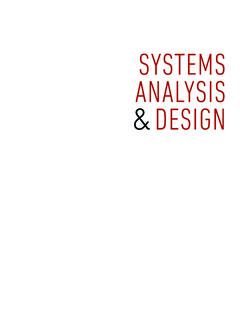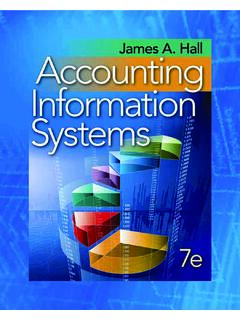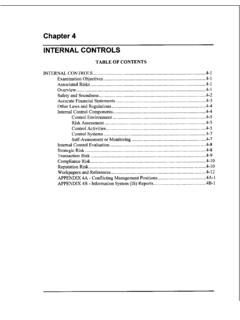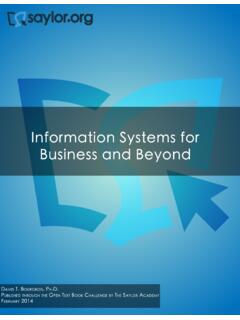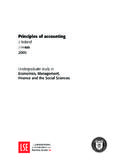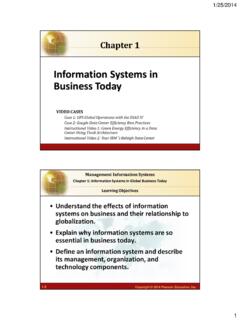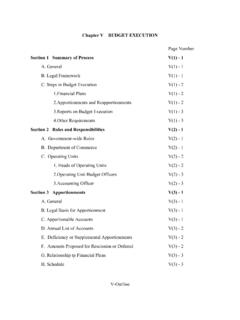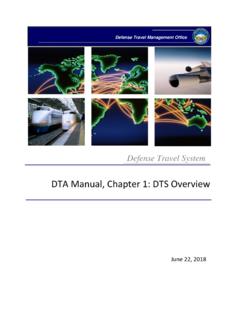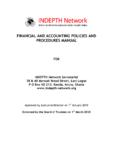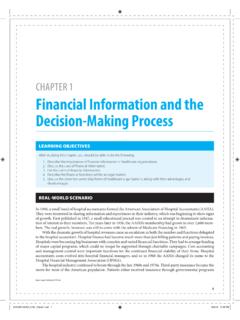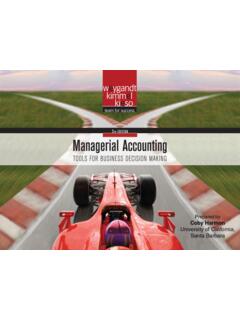Transcription of Introduction to management accounting - Pearson
1 Introduction to management accountingWelcome to the world of management accounting ! In this introductory chapter, we examine the role of management accounting within a business. To understand the context for management accounting we begin by considering the nature and purpose of a business. Thus, we first consider what businesses seek to achieve, how they are organised and how they are managed. Having done this, we go on to explore how management accounting information can be used within a business to improve the quality of managers decisions. We also identify the characteristics that management accounting information must possess to fulfil its role. management accounting has undergone many changes in response to developments in the business environment and in business methods. In this chapter we shall discuss some of the more important changes that have OUTCOMESWhen you have completed this chapter, you should be able to: l Identify the purpose of a business and discuss the ways in which a business may be organised and Discuss the issues to be considered when setting the financial aims and objectives of a Explain the role of management accounting within a business and describe the key qualities that management accounting information should Explain the changes that have occurred over time in both the role of the management accountant and the type of information provided by management accounting to create your own personalised Study PlanPPPPPPPP rrroooooooofffffffsssssss::::: FFFFF iiiiFile nott fforldistribonOUTbutioave fy the y be oDiscuobjewithout atny chn buant chwpriorsare mg infodecisnmpermission ng!
2 Iing we begiderfrfrom Pearson nt EducationEEEEEEEEEEEEEEEEEEEEEEEEEEEEEEE EEEEEEEE dddddddddddddddddddddddddddddddddddddddd ddddddddddddddddddddddddddduuuuuuuuuuuuu uuuuuuuuuuuuuuuuuuuuuuuuuuuuuuuuuuuuuuuu uuuuuuuuuuuuuuuuuuuuuuuuuuuuuuuuuuuuuuuu uuuuuuuuuuuuuuuucccccccccccccccccccccccc cccccccccccccccccccccccccccccccccccccccc cccccccccccccccccaaaaaaaaaaaaaaaaaaaaaaa aaaaaaaaaaaaaaaaaaaaaaaaaaaatttttCHAPTER 1 Introduction TO management ACCOUNTING2 What is the purpose of a business? Peter Drucker, an eminent management thinker, has argued that The purpose of business is to create and keep a customer (see reference 1 at the end of the chapter). Drucker defi ned the purpose of a business in this way in 1967, at a time when most businesses did not adopt this strong customer focus. His view therefore represented a radical challenge to the accepted view of what businesses do.
3 Forty-fi ve years on, however, his approach has become part of the conventional wisdom. It is now widely recognised that, in order to succeed, businesses must focus on satisfying the needs of the customer. Although the customer has always provided the main source of revenue for a business, this has often been taken for granted. In the past, too many businesses have assumed that the customer would readily accept whatever services or products were on offer. When competition was weak and customers were passive, businesses could operate under this assumption and still make a profi t. However, the era of weak competition has passed. Today, customers have much greater choice and are much more assertive concerning their needs. They now demand higher quality services and goods at cheaper prices. They also require that services and goods be delivered faster with an increasing emphasis on the product being tailored to their individual needs.
4 If a business cannot meet these needs, a competitor business often can. Thus the business mantra for the current era is the customer is king ; most businesses now recognise this fact and organise themselves accordingly. Real World provides an illustration of how one very successful UK business recognises the supremacy of the customer. What is the purpose of a business? REAL WORLD Checking out the customers Tesco plc, the UK supermarket business, has been highly successful at expanding its operations and generating wealth for its owners (the shareholders). In an interview with the Financial Times , the business s chief executive (most senior manager) Sir Terry Leahy explained how this profitable expansion is being achieved. He said: The big change for Tesco came when we stopped being a company with a marketing department and became a marketing company.
5 We put the customer right at the heart of the business and their requirements drove everything we did. It s not too strong to say we became obsessed with customers. Real marketing, that is, understanding people s lives and needs and responding to them with products and services, I believe lies at the heart of business success. Later in the interview Sir Terry added: We never forget customers have a choice of stores and if we don t satisfy them they will go elsewhere. Source : Ask the expert: Tesco s Sir Terry Leahy , Financial Times , 2 June 2006. FTProofs: File notot for ate Wdistributionratine, the his prhange foame a withitwithooooouuuutttttt oue cusermaprior on ofn mer. mer. permission he erhe er and are and aqualityqualitgoods bgoods ored to ed tor businebusinkingng ; mo ; mgghhfrom venuenusinessesnessesproducroducbusinebu sinPearson defi neefi ns did ndid nhallengallenghis apphis apped that, that,omer.
6 Omer. efefEducationness ness dddddddddd HOW ARE BUSINESSES ORGANISED?3 How are businesses organised? Nearly all businesses that involve more than a few owners and/or employees are set up as limited companies. This means that the fi nance will come from the owners (share-holders) both in the form of a direct cash investment to buy shares (in the ownership of the business) and through the shareholders allowing past profi ts, which belong to them, to be reinvested in the business. Finance will also come from lenders (banks, for example), who earn interest on their loans, and from suppliers of goods and services being prepared to supply on credit, with payment occurring a month or so after the date of supply, usually on an interest-free basis. In larger limited companies, the owners (shareholders) are not involved in the daily running of the business; instead they appoint a board of directors to manage the busi-ness on their behalf.
7 The board is charged with three major tasks: l setting the overall direction and strategy for the business; l monitoring and controlling the activities of the business; and l communicating with shareholders and others connected with the business. Each board has a chairman, elected by the directors, who is responsible for running the board in an effi cient manner. In addition, each board has a chief executive offi cer (CEO), or managing director, who is responsible for running the business on a day-to-day basis. Occasionally, the roles of chairman and CEO are combined, although it is usually considered to be a good idea to separate them in order to prevent a single indi-vidual having excessive power. The board of directors represents the most senior level of management . Below this level, managers are employed, with each manager being given responsibility for a par-ticular part of the business s operations.
8 How are businesses organised? Activity Why are most larger businesses not managed as a single unit by one manager? Three common reasons are: l The sheer volume of activity or number of staff employed makes it impossible for one person to manage them. l Certain business operations may require specialised knowledge or expertise. l Geographical remoteness of part of the business operations may make it more practical to manage each location as a separate part, or set of separate parts. The operations of a business may be divided for management purposes in different ways. For smaller businesses offering a single product or service, separate departments are often created, with each department responsible for a particular function (such as marketing, personnel and fi nance). The managers of each department will then be accountable to the board of directors.
9 In some cases, individual board members may also be departmental managers. A typical departmental structure, organised along functional lines, is set out in Figure . Proofs: File not T Tfor rdistributioniononer bn reaseer volun to mtain bGeograto mhoutperatioeratiwwwwwiiiiittttttthhhhhh hprior sepaeps the mothe mh each h eachononpermission ness; ess; usiness; asinessnnectednnecterectors, wctors,each boeach sible forble fman anman arateratfrom ot invot invoectors ttors tr taskstaskPearson rs (sh(shownerwnerch beloh beloders (bers (boods anods annth ornth orEducationtionset upset upddddddddddduuuuuuuuuuuuuuuuuuuuuuuuCHA PTER 1 Introduction TO management ACCOUNTING4 For large businesses that have a diverse geographical spread and/or a wide product range, the simple departmental structure set out in Figure will usually have to be adapted.))))
10 Separate divisions are often created for each geographical area and/or major product group. Each division will be managed separately and will usually enjoy a degree of autonomy. Within each division, however, departments will often be created and organised along functional lines. Some functions providing support across the Supercoach Ltd owns a small fleet of coaches that it hires out with drivers for private group travel. The business employs about 50 people. It might be depart-mentalised as follows:l Marketing department, dealing with advertising, dealing with enquiries from potential customers, maintaining good relationships with existing customers and entering into contracts with Routing and personnel department, responsible for the coach drivers routes, schedules, staff duties and rotas, and problems that arise during a particular job or Coach maintenance department, looking after repair and maintenance of the coaches, buying spares, giving advice on the need to replace old or inefficient Finance department, responsible for managing the cash flows, borrowing, use of surplus funds, payment of wages and salaries, billing and collecting charges to customers.

